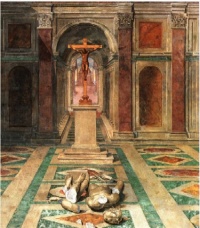Persecution of pagans in the late Roman Empire
From The Art and Popular Culture Encyclopedia
(Difference between revisions)
| Revision as of 12:51, 11 May 2024 Jahsonic (Talk | contribs) (Decline of Greco-Roman polytheism moved to Persecution of pagans in the late Roman Empire) ← Previous diff |
Revision as of 12:54, 11 May 2024 Jahsonic (Talk | contribs) Next diff → |
||
| Line 1: | Line 1: | ||
| - | [[Image:Tommaso.Laureti.Triumph.of.Christianity.jpg|right|thumb|200px|''[[Triumph of Christianity]]'' by [[Tommaso Laureti]] (1530-1602), ceiling painting in the [[Sala di Constantino]], [[Apostolic Palace|Vatican Palace]]. Images like this one celebrate the destruction of ancient [[Paganism|pagan]] culture and the victory of [[Christianity]].]] | + | [[Image:Tommaso.Laureti.Triumph.of.Christianity.jpg|right|thumb|200px|''[[Triumph of Christianity]]'']] |
| {{Template}} | {{Template}} | ||
| - | Religion in the [[Greco-Roman world]] at the time of the [[Constantinian shift]] mostly comprised three main currents: | + | '''Persecution of pagans in the late Roman Empire''' began during the reign of [[Constantine the Great]] ({{Reign}}306–337) in the military colony of [[Aelia Capitolina]] ([[Jerusalem]]), when he destroyed a pagan temple for the purpose of constructing a Christian church. |
| - | *the [[Religion in ancient Greece|traditional religions of ancient Greece]] and [[Religion in ancient Rome|Rome]]; | + | |
| - | *the official [[Imperial cult (ancient Rome)|Roman imperial cult]]; | + | |
| - | *various [[Greco-Roman mysteries|mystery religion]]s, such as the [[Eleusinian Mysteries]] and the mystery cults of [[Cybele]], [[Mithraic mysteries|Mithras]], and the [[syncretism|syncretized]] [[Isis]]. | + | |
| - | + | ||
| - | [[Early Christianity]] grew gradually in [[Early centers of Christianity#Rome|Rome]] and the [[Roman Empire]] from the [[Christianity in the 1st century|1st]] to [[Christianity in the 4th century|4th]] centuries, when it was legalized and, in its [[First Council of Nicaea|Nicene form]] became the [[state church of the Roman Empire]] with the [[Edict of Thessalonica]] of 380. [[Hellenistic]] polytheistic traditions survived in pockets of Greece throughout Late Antiquity. The [[Neoplatonic]] ''[[Plato's Academy|Academy]]'' was shut down by [[Justinian I]] in 529, a date sometimes taken to mark the end of [[Classical Antiquity]]. | + | |
| ==See also== | ==See also== | ||
| - | * [[Christianity and paganism]] | + | *[[Greco-Roman world]] |
| - | * [[Christianization]] | + | *[[Hellenistic religion]] |
| - | * [[Constantinian shift]] | + | *[[History of Christian thought on persecution and tolerance]] |
| - | * [[Damascius]] | + | *[[Pentarchy]] |
| - | * [[Early Christianity]] | + | *[[Paradox of tolerance]] |
| - | * [[Hellenistic Judaism]] | + | *[[Religious policies of Constantius II]] |
| - | * [[Hellenistic religion]] | + | *[[Persecution of pagans under Theodosius I]] |
| - | * [[Historical persecution by Christians]] | + | *[[Religion in ancient Rome]] |
| - | * [[Late Antiquity]] | + | *[[Religious persecution in the Roman Empire]] |
| - | * [[Mithraism]] | + | *[[Restoration of paganism from Julian until Valens]] |
| - | * [[Neoplatonism and Christianity]] | + | *[[Revival of Roman paganism]] |
| - | * [[Persecution of pagans by the Christian Roman Empire]] | + | |
| - | * [[Pseudo-Dionysius]] | + | |
| - | * [[Roman imperial cult]] | + | |
| - | * [[Roman polytheistic reconstructionism]] | + | |
| - | * [[Christianization]] | + | |
| - | * [[Christianity and other religions]] | + | |
| - | * [[Christianity and paganism]] | + | |
| - | * [[Persecution of Christians in the Roman Empire]] | + | |
| - | * [[Religious policies of Constantine the Great]] | + | |
| - | * [[Religious policies of Constantius II]] | + | |
| - | * [[Persecution of pagans in the late Roman Empire]] | + | |
| - | * [[Persecution of pagans under Theodosius I]] | + | |
| - | * [[Anti-paganism policies of the early Byzantine Empire]] | + | |
| - | * [[Restoration of paganism from Julian until Valens]] | + | |
| - | * [[Revival of Roman paganism]] | + | |
| - | * [[History of Christianity]] | + | |
| - | * [[Christianity and violence]] | + | |
| - | * [[History of Christian thought on persecution and tolerance]] | + | |
| - | * [[Timeline of Christianity]] | + | |
| {{GFDL}} | {{GFDL}} | ||
Revision as of 12:54, 11 May 2024
|
Related e |
|
Featured: |
Persecution of pagans in the late Roman Empire began during the reign of Constantine the Great (Template:Reign306–337) in the military colony of Aelia Capitolina (Jerusalem), when he destroyed a pagan temple for the purpose of constructing a Christian church.
See also
- Greco-Roman world
- Hellenistic religion
- History of Christian thought on persecution and tolerance
- Pentarchy
- Paradox of tolerance
- Religious policies of Constantius II
- Persecution of pagans under Theodosius I
- Religion in ancient Rome
- Religious persecution in the Roman Empire
- Restoration of paganism from Julian until Valens
- Revival of Roman paganism
Unless indicated otherwise, the text in this article is either based on Wikipedia article "Persecution of pagans in the late Roman Empire" or another language Wikipedia page thereof used under the terms of the GNU Free Documentation License; or on research by Jahsonic and friends. See Art and Popular Culture's copyright notice.


